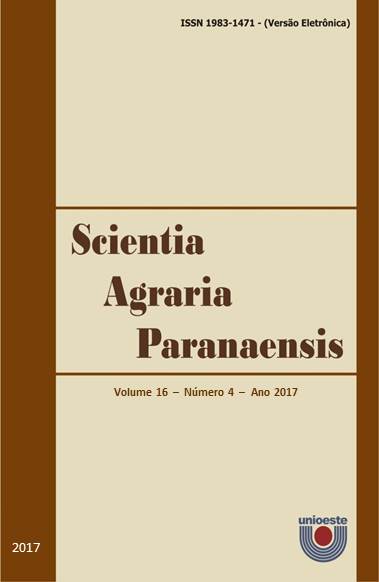Relationship cotton genotypes and ramularia leaf spot in Mato Grosso
Supporting Agencies
Keywords:
Gossypium hirsutum L., Ramularia areola, resistência de cultivares.Abstract
The objective of this study was to evaluate the performance of cotton genotypes and resistance ramularia leaf spot in two sowing dates. The experimental design was a randomized block with 18 genotypes of cotton and 5 repetitions. They assessed the area under the disease progress curve (AUDPC) and yields, to which were held 8 reviews of disease severity in each third of the plant, lower, middle and upper. The IMA 08-12427 genotype showed lower average total AUDPC, regardless of sowing time. Regarding yield, TMG 82 WS genotypes BRS 371, DP 555 BG RR, FM 982 GL and BRS 372 obtained the highest yield in the first seeding time, ranging from 3,021.97 to 3,623.57 kg ha-1, and classified as resistance as MR, MR, MS, S, MS, respectively. Among the 18 genotypes, the first sowing had seven MR six MS-five S, while in the second epoch presented three MR four MS ten S and AS.Downloads
Published
20-12-2017
How to Cite
AMBRÓSIO, J.; ASCARI, J. P.; DIAS, L. D. E.; ARAÚJO, D. V.; SILVA, D. M. V. da; CIA, E. Relationship cotton genotypes and ramularia leaf spot in Mato Grosso. Scientia Agraria Paranaensis, [S. l.], v. 16, n. 4, p. 468–474, 2017. Disponível em: https://e-revista.unioeste.br/index.php/scientiaagraria/article/view/15454. Acesso em: 30 may. 2025.
Issue
Section
Scientific Article
License
Aviso de Direito Autoral Creative Commons
Política para Periódicos de Acesso Livre
Autores que publicam nesta revista concordam com os seguintes termos:
1. Autores mantém os direitos autorais e concedem à revista o direito de primeira publicação, com o trabalho simultaneamente licenciado sob a Licença Creative Commons Attribution que permite o compartilhamento do trabalho com reconhecimento da autoria e publicação inicial nesta revista.2. Autores têm autorização para assumir contratos adicionais separadamente, para distribuição não-exclusiva da versão do trabalho publicada nesta revista (ex.: publicar em repositório institucional ou como capítulo de livro), com reconhecimento de autoria e publicação inicial nesta revista.
3. Autores têm permissão e são estimulados a publicar e distribuir seu trabalho online (ex.: em repositórios institucionais ou na sua página pessoal) a qualquer ponto antes ou durante o processo editorial, já que isso pode gerar alterações produtivas, bem como aumentar o impacto e a citação do trabalho publicado (Veja O Efeito do Acesso Livre).
Licença Creative Commons
Esta obra está licenciada com uma Licença Creative Commons Atribuição-NãoComercial-CompartilhaIgual 4.0 Internacional, o que permite compartilhar, copiar, distribuir, exibir, reproduzir, a totalidade ou partes desde que não tenha objetivo comercial e sejam citados os autores e a fonte.


